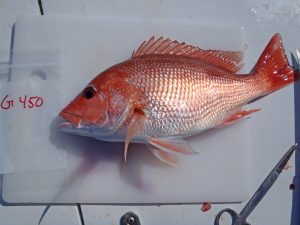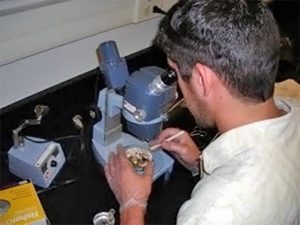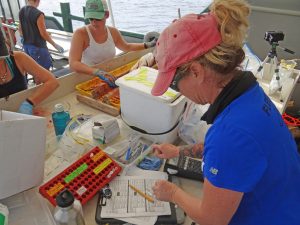Studies Identify Oil Spill Effects in Deep Sea Fish
– October 13, 2015
Two studies show that some demersal fishes living in waters likely contaminated by the Deepwater Horizon oil spill exhibited elevated hydrocarbon concentrations and experienced shifts in diet and trophic level.
Scientists in the study PAH Exposure in Gulf of Mexico demersal fishes, post-Deepwater Horizon (Environmental Science & Technology) assessed the bile of golden tilefish, king snake eel, and red snapper. They used bile polycyclic aromatic hydrocarbon (PAH) metabolites as a biomarker of oil exposure and found PAH metabolite concentrations that suggest exposure from the spill.
Naphthalene metabolites in golden tilefish were significantly higher than in red snapper (four times) or king snake eel (six to nine times) based on samples collected from 2011 to 2013. Naphthalene concentration had decreased in red snapper (58%) and king snake eel (37%) by 2013, to levels similar to those found in Gulf of Mexico fish pre-spill.However, concentrations remained high in golden tilefish and are among the highest concentrations measured in fishes globally.
Benzo[a]pyrene metabolite concentrations were similar for all three species at levels considered relatively low compared to Gulf of Mexico and global data. PAH metabolites concentrations in red snapper bile decreased with distance from the spill site, another indication that the source of observed elevated PAHs was the 2010 spill. Data collected for this study constitute one of the largest data sets for PAHs in fish bile and the largest for the Gulf of Mexico.
Scientists in the study Changes in red snapper diet and trophic ecology following the Deepwater Horizon oil spill (Marine and Coastal Fisheries: Dynamics, Management, and Ecosystem Science) extended a 2009 red snapper study through August 2011. They found significant shifts in red snapper diet and position in the food chain after the spill. There was a significant decrease (55%-65%) across all size classes post-spill in zooplankton consumption and an increase (15%-22%) in higher trophic level prey consumption (crab, squid, and shrimp). The team hypothesized that increased consumption of higher trophic-level prey may be an indication of declined zooplankton abundance, not an increase in higher tropic-level prey abundance.
The decreased zooplankton consumption is consistent with the documented post-spill increase in marine snow events and zooplankton mortality. Analysis of muscle tissue indicated an enrichment in Nitrogen-15, which is consistent with higher trophic level prey being consumed by red snapper following the Deepwater Horizon spill. The authors said that the corroborating observations of diet and trophic-level shifts provided evidence of Deepwater Horizon spill impacts to red snapper feeding ecology in the study area.
These studies support previous findings that fish life history and physiology play significant roles in exposure and uptake of pollutants. The authors of both studies call for continued analyses, using tissue samples already collected, to better understand species-specific differences and more detailed characterization of PAHs distribution, effects, and source and oil spill effects on the food web.
The authors of the Environmental Science & Technology study are Susan M. Snyder, Erin L. Pulster, Dana L. Wetzel, and Steven A. Murawski.
The authors of the Marine and Coastal Fisheries: Dynamics, Management, and Ecosystem Science study are Joseph H. Tarnecki and William F. Patterson III.
************
This research was made possible in part by a grant from the Gulf of Mexico Research Initiative (GoMRI) to the Center for Integrated Modeling and Analysis of Gulf Ecosystems (C-IMAGE). Other funding sources included the Florida Fish Wildlife Research Institute and the National Oceanic and Atmospheric Administration Fisheries’ Cooperative Research Program.
The Gulf of Mexico Research Initiative (GoMRI) is a 10-year independent research program established to study the effect, and the potential associated impact, of hydrocarbon releases on the environment and public health, as well as to develop improved spill mitigation, oil detection, characterization and remediation technologies. An independent and academic 20-member Research Board makes the funding and research direction decisions to ensure the intellectual quality, effectiveness and academic independence of the GoMRI research. All research data, findings and publications will be made publicly available. The program was established through a $500 million financial commitment from BP. For more information, visit https://gulfresearchinitiative.org/.
© Copyright 2010- 2017 Gulf of Mexico Research Initiative (GoMRI) – All Rights Reserved. Redistribution is encouraged with acknowledgement to the Gulf of Mexico Research Initiative (GoMRI). Please credit images and/or videos as done in each article. Questions? Contact web-content editor Nilde “Maggie” Dannreuther, Northern Gulf Institute, Mississippi State University (maggied@ngi.msstate.edu).








